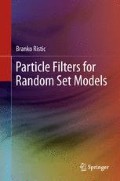Abstract
This chapter presents some practical estimation problems involving imprecision, including source localization, monitoring and prediction of an epidemic, localization using spatially referring natural language statements, and classification using the imprecise likelihood models.
Access this chapter
Tax calculation will be finalised at checkout
Purchases are for personal use only
References
N. Patwari, J. N. Ash, S. Kyperountas, R. L. M. A. O. Hero III, and N. S. Correal, “Locating the nodes”, IEEE Signal Processing Magazine, pp. 54–68, July 2005.
J. O. Berger, Statistical Decision Theory and Bayesian Analysis. New York: Springer Series in Statistics, 1985.
B. W. Silverman, Density estimation for statistical and data analysis. Chapman and Hall, 1986.
F. Brauer, P. V. D. Driessche, and J. Wu, eds., Mathematical Epidemiology. Lecture Notes in Mathematics, Springer, 2008.
R. M. Anderson and R. M. May, “Population biology of infectious diseases: Part 1”, Nature, vol. 280, pp. 361–367, 1979.
P. D. Stroud, S. J. Sydoriak, J. M. Riese, J. P. Smith, S. M. Mniszewski, and P. R. Romero, “Semi-empirical power-law scaling of new infection rate to model epidemic dynamics with inhomogeneous mixing”, Mathematical Bioscinese, vol. 203, pp. 301–318, 2006.
A. S. Novozhilov, “On the spread of epidemics in a closed heterogeneous population”, Mathematical Bioscienses, vol. 215, no. 2, p. 177185, 2008.
B. Ristic, A. Skvortsov, and M. Morelande, “Predicting the progress and the peak of an epidemic”, in Proc. IEEE Intern. Conf. Acoustic Speech and Signal Proc. (ICASSP), (Taipei, Taiwan), pp. 513–516, 2009.
A. Skvortsov and B. Ristic, “Monitoring and prediction of an epidemic outbreak using syndromic observations”, Mathematical biosciences, vol. 240, pp. 12–19, 2012.
M. Wagner, A. Moore, and R. Aryel, Handbook of Biosurveillance. Elsevier, 2006.
A. Wilson, G. Wilson, and D. Olwell, Statistical Methods in Counterterrorism: Game Theory, Modeling, Syndromic Surveillance, and Biometric Authentication. Springer, 2006.
C. Chew and G.Eysenbach, “Pandemics in the age of Twitter: content analysis of tweets during the 2009 h1n1 outbreak”, PLoS One, vol. 5, no. 11, p. e14118, 2010.
N. M. Schuster, M. Rogers, and L. Jr, “Using search engine query data to track pharmaceutical utilization: A study of statin”, The American Journal of Managed Care, vol. 16, no. 8, pp. e215–e219, 2010.
A. Signorini, A. M. Segre, and P. M. Polgreen, “The use of Twitter to track levels of disease activity and public concern in the u.s. during the influenza a h1n1 pandemic”, PLoS One, vol. 6, no. 5, p. e19467, 2011.
A. Culotta, “Detecting influenza outbreaks by analyzing Twitter messages”, in Proc. 2010 Conf. on Knowledge Discovery and Data Mining, (Washington, D.C.), 2010.
J. Ginsberg, M. Mohebbi, R. S. Patel1, L. Brammer, M. S. Smolinski, and L. Brilliant, “Detecting influenza epidemics using search engine query data”, Nature, vol. 457, pp. 1012–1015, 2009.
R.Connell, P.Dawson, and A.Skvortsov, “Comparison of an agent-based model of disease propagation with the generalised SIR epidemic model”, tech. rep., DSTO, 2009.
A. Bishop and B. Ristic, “Fusion of natural language propositions: Bayesian random set framework”, in Proc. 14th Int. Conf. Information Fusion, (Chicago, USA), July 2011.
A. N. Bishop and B. Ristic, “Information fusion with spatially referring natural language statements”, IEEE Trans. Aerospace and Electronic Systems, 2012. (in print).
W. Hayward and M. Tarr, “Spatial language and spatial representation”, Cognition, vol. 55, no. 1, pp. 39–84, 1995.
J. Bateman, J. Hois, R. Ross, and T. Tenbrink, “A linguistic ontology of space for natural language processing”, Artificial Intelligence, 2010.
B. Ristic and P. Smets, “Target classification approach based on the belief function theory”, IEEE Trans. Aerospace and Electronic Systems, vol. 41, pp. 574–583, April 2005.
P. Smets, “Data fusion in the transferable belief model”, in Proc. 3rd Intern. Conf. Information Fusion (FUSION 2000), (Paris, France), pp. PS21-33, 2000.
R. Yager and L. Liu, eds., Classic works of the DempsterShafer theory of belief functions. Studies in fuzziness and soft computing, Springer, 2008.
P. Smets, “Belief functions: the disjunctive rule of combination and the generalized Bayesian theorem”, International Journal of Approximate Reasoning, vol. 9, pp. 1–35, 1993.
P. Smets, “Decision making in the TBM: The necessity of the pignistic transformation”, International Journal of Approximate Reasoning, vol. 38, pp. 133–147, 2005.
R. Mahler, Statistical Multisource Multitarget Information Fusion. Artech House, 2007.
G. Shafer, A mathematical theory of evidence. Princeton University Press, 1976.
F. Voorbraak, “A computationally efficient approximation of Demspter-Shafer theory”, Int. J. Man-Machine Studies, vol. 30, pp. 525–536, 1989.
Author information
Authors and Affiliations
Corresponding author
Rights and permissions
Copyright information
© 2013 Springer Science+Business Media New York
About this chapter
Cite this chapter
Ristic, B. (2013). Applications Involving Non-standard Measurements. In: Particle Filters for Random Set Models. Springer, New York, NY. https://doi.org/10.1007/978-1-4614-6316-0_3
Download citation
DOI: https://doi.org/10.1007/978-1-4614-6316-0_3
Published:
Publisher Name: Springer, New York, NY
Print ISBN: 978-1-4614-6315-3
Online ISBN: 978-1-4614-6316-0
eBook Packages: EngineeringEngineering (R0)

